
views
Writing a Negative Reference

Consider refusing to write a reference. You aren’t obligated to write a reference unless it says in the employment contract that you will give one. For that reason, you should consider saying “no.” Negative references can be more trouble than they are worth. If the person asking for the reference is a former employee, you can tell them they would be better off choosing someone more familiar with their recent work. However, if the employee is a current employee, you may be tempted to give a reference just to get rid of them.

Tell the employee the reference will be negative. Don’t beat around the bush. Instead, tell the employee you can’t write a positive reference. This will give the employee a chance to choose someone else for a reference. You can say, “Sorry, Janet, I’m not sure I can write a really strong reference. Are you sure you can’t find someone else?”
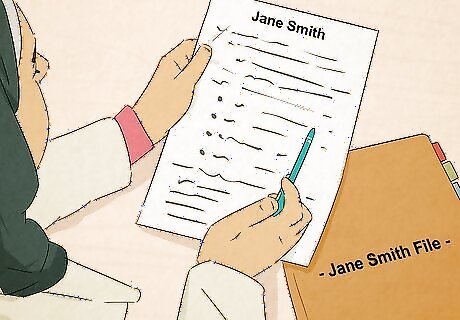
Review the employee’s file. If you choose to go ahead with the reference, you should carefully review the employee’s file so that you only state accurate information. Remember that you can be sued for anything false in the reference. Accordingly, make sure everything you write in your reference is factual. For example, the employee could sue you for defamation, which is a false statement that injures the person. An employee can sue for defamation if you lie and the lie costs the employee a job.
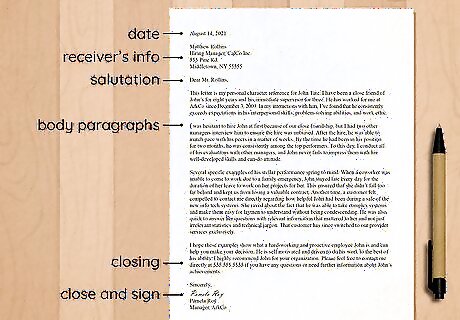
Format your letter. It’s a better idea to write an employee reference than give one over the phone. By writing a letter, you preserve proof of exactly what you told a potential employer. Set up the letter like a standard business letter. Choose a font that most people can read. Generally, Times New Roman or Arial 12 point works best.
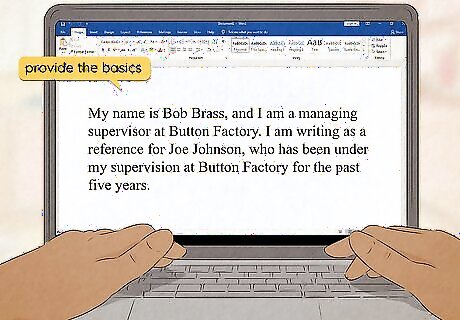
Stick to the facts. You should keep the reference as brief as possible. You can begin the review by providing the basics about the employee, such as the following: when the employee worked for you job title their pay rate (optional)
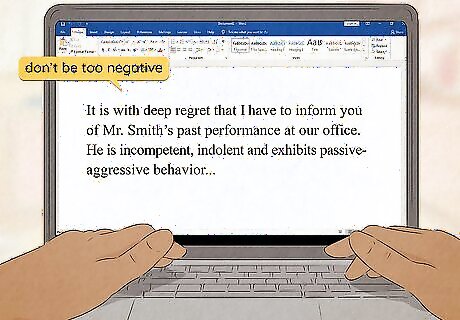
Avoid being too negative. After providing the facts, you may want to give your impressions of the employee. You need to be careful here. Make sure not to be too negative. Avoid speculation or relaying gossip you heard about the employee. Instead, base your opinions on your direct observations. Remember that you can be negative—provided the negative information is accurate. You can avoid being too negative by providing some balance. Think of something positive you can say about the employee. For example, an employee may have been incompetent but pleasant. You can praise their sunny attitude. Alternately, the employee might have been a bad fit for your company based on personality. However, they may have done detailed work.
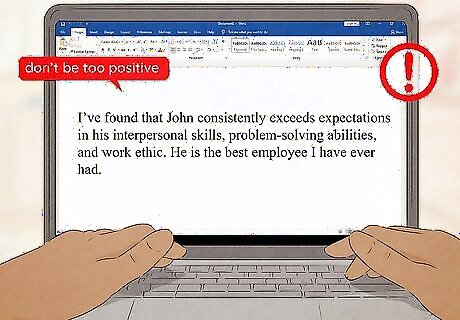
Don’t be too positive. You also shouldn’t cover up any employee misconduct. You may be tempted, especially if the employee is weak and you want them to move on. However, if you lie, then a potential employer could sue you for misrepresenting the truth. For example, avoid saying “Karen is the best employee I have ever had” if you have evidence in the employee’s file that they were a mediocre employee. Positive comments also need to be supported with evidence. Failure to disclose relevant information is also a problem. For example, a dental assistant may have shown up drunk or high and proceeded to try and clean teeth. You will need to disclose that type of information to a potential employer in order to protect yourself from being sued. Don’t simply say you “fired” the employee. Also disclose thefts, violent behavior, and sexual harassment in addition to drug or substance abuse problems.

Show the employee your letter. Give the employee another chance to decide not to use you as a reference. Show them the letter before you mail it out. Ask the employee a second time if they want to use your reference letter. Give them about a week to decide. Wait for them to give you the go ahead before sending it out. Usually, an employee will decide not to use a negative reference. However, they could be in a tight spot. A potential employer might be insisting that they get a reference from their current employer.

Be open to revisions. If the employee wants the letter but dislikes your comments, ask if you can just provide the factual details of their employment: date, pay, etc. If so, you can strip out any negative commentary. You should also consider having the employee sign a release.
Using a Release
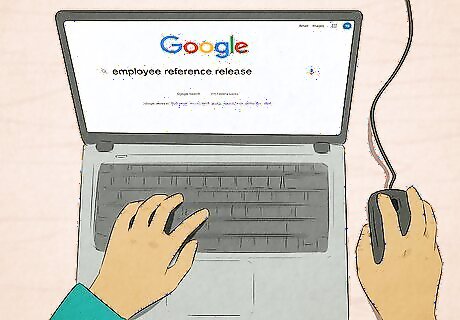
Find sample releases. When an employee signs a release, they agree not to sue you for defamation or any other injury suffered as a result of the reference. There are many samples you can use online as models when drafting your own. Search “employee reference release” online. Realize that the release doesn’t protect you from lawsuits from potential employers for misrepresentation. You must still be 100% factual and honest in your reference.
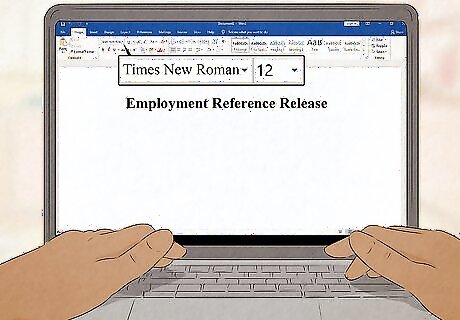
Begin drafting the release. You can type up your own basic employment reference release by opening a blank word processing document and setting the font to a readable size and style, e.g., 12-point type. Insert a title at the top of the page—“Employment Reference Release.” You should probably set up the document as a template, with blank lines for information that will change with each release. This way, you can use the release more than once.
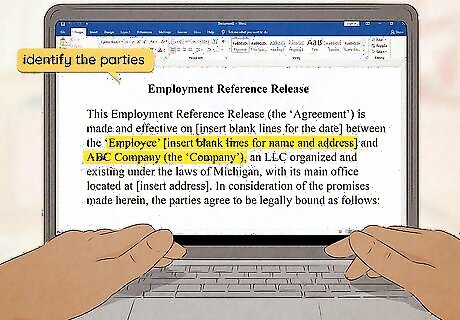
Identify the parties. The release is a legal agreement between you (the company) and an employee. Provide this information at the top of the page underneath the title. For example, you can write, “This Employment Reference Release (the ‘Agreement’) is made and effective on [insert blank lines for the date] between the ‘Employee’ [insert blank lines for name and address] and ABC Company (the ‘Company’), an LLC organized and existing under the laws of Michigan, with its main office located at [insert address]. In consideration of the promises made herein, the parties agree to be legally bound as follows:”
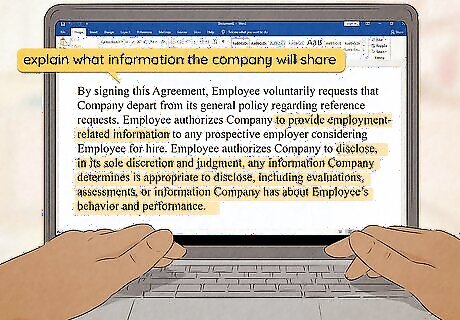
Explain what information the company will share. Insert a paragraph where you lay out the information you will share with a potential employer. Remember to reserve the right to decide what information you will release. For example, you can write, “By signing this Agreement, Employee voluntarily requests that Company depart from its general policy regarding reference requests. Employee authorizes Company to provide employment-related information to any prospective employer considering Employee for hire. Employee authorizes Company to disclose, in its sole discretion and judgment, any information Company determines is appropriate to disclose, including evaluations, assessments, or information Company has about Employee’s behavior and performance.”
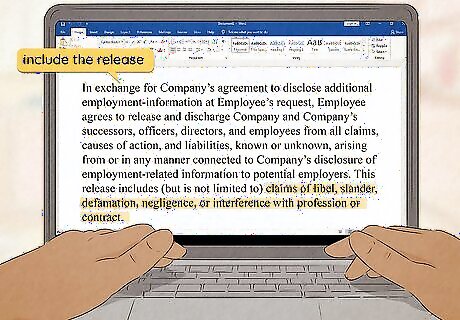
Include the release. The release is an explicit promise from the employee to not hold you legally responsible for any fallout from your reference. Remember to obtain protection for the company as well as for individual employees who give the reference. For example, you can write: “In exchange for Company’s agreement to disclose additional employment-information at Employee’s request, Employee agrees to release and discharge Company and Company’s successors, officers, directors, and employees from all claims, causes of action, and liabilities, known or unknown, arising from or in any manner connected to Company’s disclosure of employment-related information to potential employers. This release includes (but is not limited to) claims of libel, slander, defamation, negligence, or interference with profession or contract.”
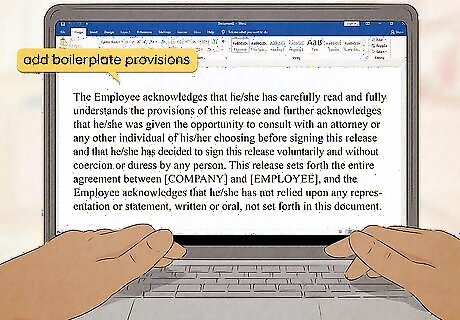
Add boilerplate provisions. You’ll need these provisions to protect you in case the employee later objects to your reference. Include the following provisions: The employee has carefully read the agreement. The employee had an opportunity to consult a lawyer or any person of their choosing before signing the agreement. The employee has signed the release voluntarily and without coercion. The release contains the entire agreement between the parties and replaces all other agreements on the subject matter.

Ask the employee to sign. Insert a signature block for both a company representative and the employee to sign. Don’t mail out a reference letter until you have a signed release on file. If the employee refuses to sign a release, you should strongly consider not providing a reference beyond basic information.
Setting Up a Reference System

Come up with a company policy. By having a policy in place, you’ll know exactly how to respond to any reference request. For example, some companies have a policy of only providing bare bones information, such as the dates of employment, job title or description, and pay rate. You can set your own policy. For example, you might want to provide more extensive references for employees. If so, you can make it a policy to ask employees to sign releases before you provide a fuller reference letter.

Decide whether personal references are acceptable. Fellow coworkers might want to give references, even if the company doesn’t. You’ll need to consider whether to allow personal references and come up with policies about them. For example, a personal reference occurs when Jane Smith says, “I’m speaking as Jane Smith, but not as a representative for the company.” If you allow personal references, include a policy prohibiting the use of company letterhead or the company address. Also make sure employees state in their reference that they are not speaking on behalf of the company.

Designate one person to handle references. If you decide to provide only basic information, then pick one person in Human Resources to provide this information. By training and using one person, you’ll make fewer errors. When another person is asked to provide a reference, they should refer the employee to HR. HR should also keep detailed notes about the references they give out: who it was given to and the employee it was about.
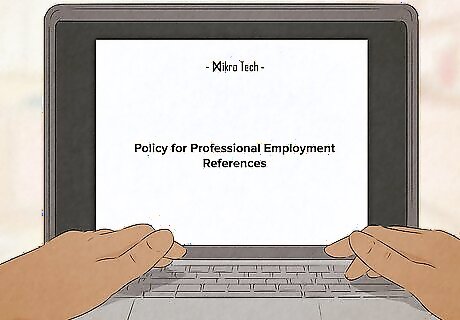
Publicize your company reference policy. Include the policy in employment contracts and employee manuals or handbooks. You want everyone to know what the company’s position is regarding work references. Also include information about a release. For example, you could publish a sample release in your employee handbook so employees can see what they are agreeing to before asking you to provide a reference.

Consult with a labor and employment lawyer. If you’re just beginning to think about references, you should consult with a lawyer to help you navigate the legal maze. Each state has different laws related to the information you can give about an employee. For example, in some states, you can only provide information about an employee with their consent. California also provides legal protection when giving answers to certain questions. You can find a lawyer by contacting your local or state bar association. Set up a consultation with the lawyer and discuss your legal obligations as an employer. Also discuss what your company’s reference policy should be.



















Comments
0 comment